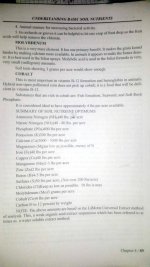I've just started digging around the web for histosol fertility management. I want to cipher out what's different or what's similar in the soil chemistry between these organic matter based lightweight soils and mineral soils.
Bigg,
If you use compost, worm castings or any other decomposed material, you are not in a media, you are in a soil. You need a real soil analysis.
Using the various soil analysis procedures at Spectrum that they have so graciously accepted doing (they only run Melich 3 normally) we have been able to dial in EVERY grower that has asked for help and ventured to do their testing with M3 and [email protected]
Even those that have not tested their soil and used gypsum or milk got response!
Let's think this through a bit.
One is that the weight per volume is lower than that of a soil and that we need to compensate for that density. In the case of Jidoka's sample, it has half the density than that of a normal soil. However, his nutrient levels across the board are very high. So what do we do in this case, put on twice as much?
JIDOKA, you really thinking about applying more fertilizer than you already have done? And would you even contemplate doubling it due to your analysis?
Everyone that has been applying more fertilizer has found that all that fertilizer is killing them without having enough Ca.
One thing is to make calculations, another is to do trials. To dial it in with calcium one has to do test strips or container tests. Different dosages in the same mix.
I would be doing this now with throw away plants in 6 inch pots and playing with my Ca concentrations, run your calculations for 85% Ca using both calcium carbonate calculated to adjust your pH if need be and then gypsum to fill in the rest.
Then start off with the right mix and plan to apply gypsum and milk over the season at key moments in an effort to try and maximize to the fullest the plants genetic potential.




